Detailed Micro-Environmental Analysis of the Dick Smith Business
VerifiedAdded on 2023/06/10
|7
|1499
|235
Report
AI Summary
This report presents a micro-environmental analysis of the Dick Smith retail chain, focusing on key aspects that influenced its business performance. The analysis begins with an examination of Dick Smith's competitors, including JB Hi-Fi, Harvey Norman, and others, highlighting their market share and financial performance. A Porter analysis is conducted to assess the bargaining power of buyers and sellers, the threat of substitution, the threat from new entrants, and the level of market competition within the Australian electronic retail market. The report then delves into public opinion surrounding Dick Smith, tracing its history from its founding to its eventual decline and closure, including factors like market share, investor behavior, and consumer trust. Furthermore, it explores government regulations that affected Dick Smith, such as electrical equipment safety standards, ACCC and consumer laws, product liability regulations, and environmental legislation, and discusses how these regulations impacted the company's operations and growth. The report concludes by summarizing the key environmental factors that contributed to the company's challenges in the Australian market.
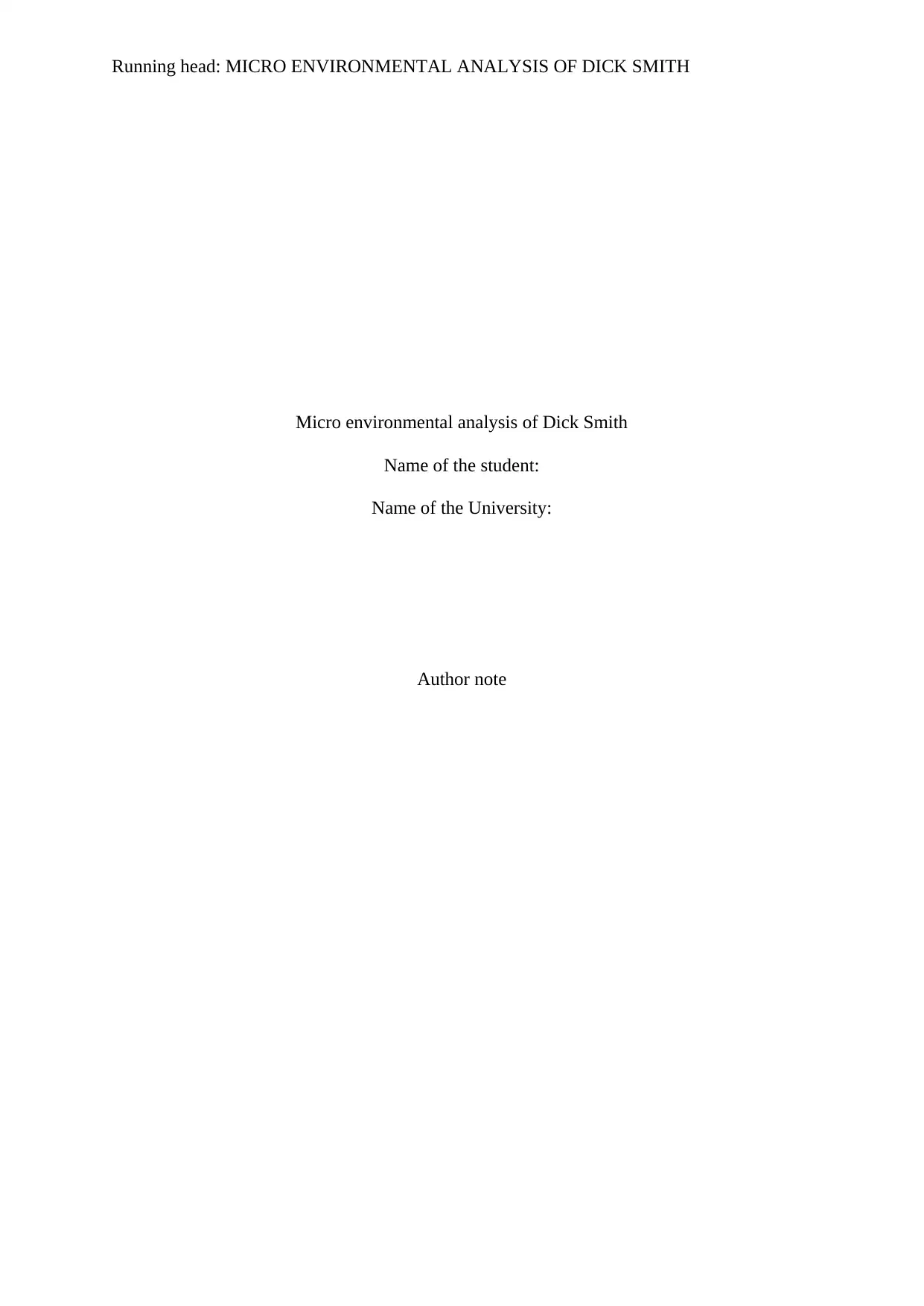
Running head: MICRO ENVIRONMENTAL ANALYSIS OF DICK SMITH
Micro environmental analysis of Dick Smith
Name of the student:
Name of the University:
Author note
Micro environmental analysis of Dick Smith
Name of the student:
Name of the University:
Author note
Paraphrase This Document
Need a fresh take? Get an instant paraphrase of this document with our AI Paraphraser
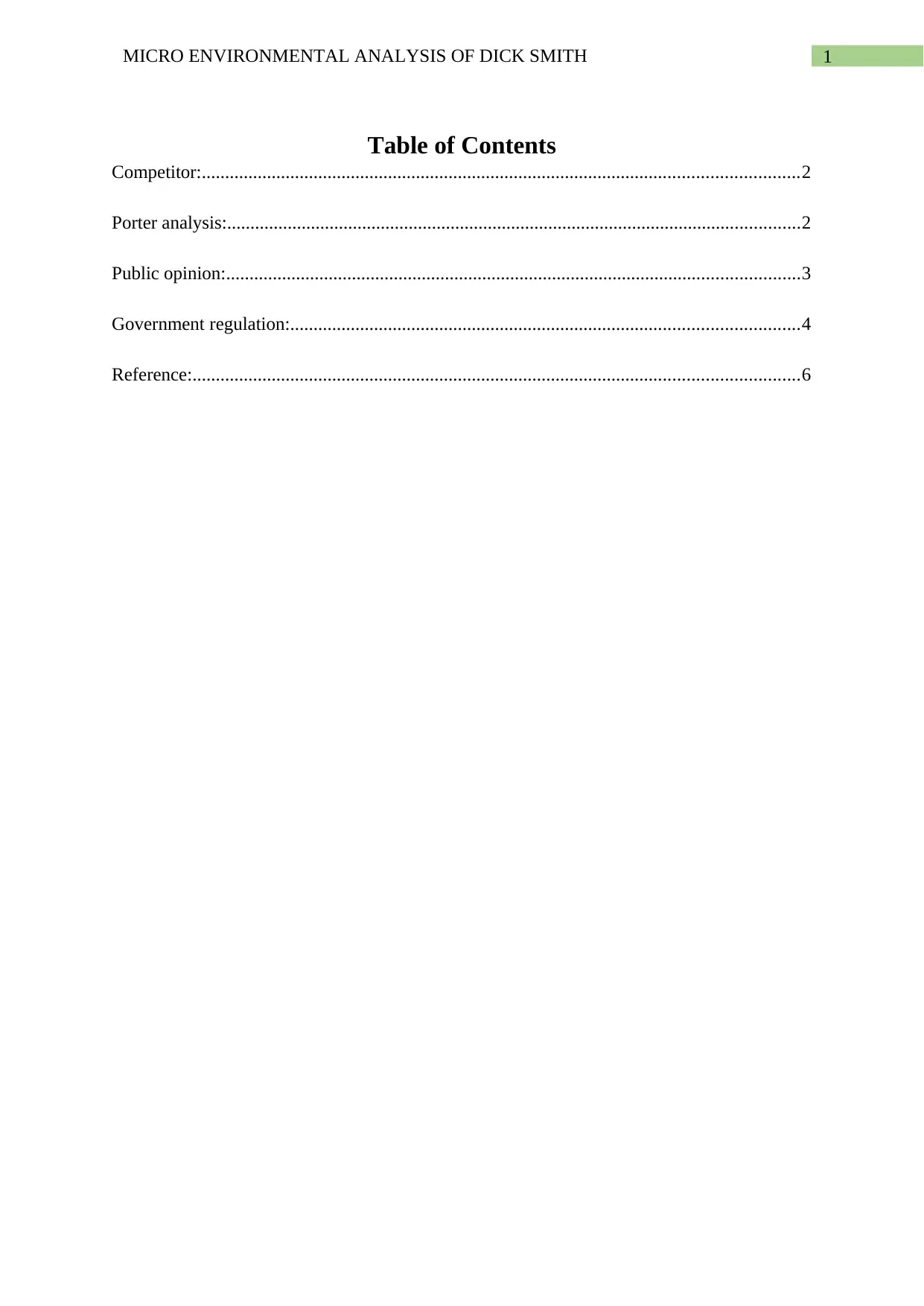
1MICRO ENVIRONMENTAL ANALYSIS OF DICK SMITH
Table of Contents
Competitor:................................................................................................................................2
Porter analysis:...........................................................................................................................2
Public opinion:...........................................................................................................................3
Government regulation:.............................................................................................................4
Reference:..................................................................................................................................6
Table of Contents
Competitor:................................................................................................................................2
Porter analysis:...........................................................................................................................2
Public opinion:...........................................................................................................................3
Government regulation:.............................................................................................................4
Reference:..................................................................................................................................6

2MICRO ENVIRONMENTAL ANALYSIS OF DICK SMITH
Competitor:
Dick Smith was one of the largest retail chain in Australia that used to sell electronic
goods, electronic project kits and different electronic components. When it comes to its
competitors, then it can be seen that there is plenty of brand available. For instance, JB Hi-Fi,
Harvey Norman, Kogan.com, officworks, Harvey Norman and others are available in the
Australian market. As per the electronic market share report, it can be seen that during 2015,
5.4% Australian electronic retail market was enjoyed by Dick Smith and compared to this, its
competitors like JB Hi-Fi had 16.1% and Harvey Norman had 15.9% showcasing the drastic
difference between the performance of the peer firms (Yang, 2018). On the other hand, if the
stock price of the competitors are compared, then it can be seen that JB Hi-Fi and Harvey
Norman, during the present day due to absence of Dick Smith is having risen in their share
price ranging from 1.65% to 5% showcasing the strong performance of the same (Pash,
2016).
Porter analysis:
Bargaining power of buyer: Moderate
Australian electronic retail market is an oligopoly market and the number of buyer is
as high as 6.6 million making it one of the highly competitive market (Jie, 2016). Under the
oligopoly market prices are competitive and the availability of shifting from one brand to
another provides the buyers moderate amount of bargaining power.
Bargaining power of seller: Moderate
Number of sellers in the Australian electronic retail market is not much higher as
compared to China, USA and Japan. There are large 6 retailers who compete in the market
that provides a competitive edge to the firms. In other hand, collusive pricing strategies of the
firm make it hard choice for the consumer to stick to only one brand that reduce the power of
market capitalisation by the firm limited. Considering both hand factors it can be argued that,
Competitor:
Dick Smith was one of the largest retail chain in Australia that used to sell electronic
goods, electronic project kits and different electronic components. When it comes to its
competitors, then it can be seen that there is plenty of brand available. For instance, JB Hi-Fi,
Harvey Norman, Kogan.com, officworks, Harvey Norman and others are available in the
Australian market. As per the electronic market share report, it can be seen that during 2015,
5.4% Australian electronic retail market was enjoyed by Dick Smith and compared to this, its
competitors like JB Hi-Fi had 16.1% and Harvey Norman had 15.9% showcasing the drastic
difference between the performance of the peer firms (Yang, 2018). On the other hand, if the
stock price of the competitors are compared, then it can be seen that JB Hi-Fi and Harvey
Norman, during the present day due to absence of Dick Smith is having risen in their share
price ranging from 1.65% to 5% showcasing the strong performance of the same (Pash,
2016).
Porter analysis:
Bargaining power of buyer: Moderate
Australian electronic retail market is an oligopoly market and the number of buyer is
as high as 6.6 million making it one of the highly competitive market (Jie, 2016). Under the
oligopoly market prices are competitive and the availability of shifting from one brand to
another provides the buyers moderate amount of bargaining power.
Bargaining power of seller: Moderate
Number of sellers in the Australian electronic retail market is not much higher as
compared to China, USA and Japan. There are large 6 retailers who compete in the market
that provides a competitive edge to the firms. In other hand, collusive pricing strategies of the
firm make it hard choice for the consumer to stick to only one brand that reduce the power of
market capitalisation by the firm limited. Considering both hand factors it can be argued that,
⊘ This is a preview!⊘
Do you want full access?
Subscribe today to unlock all pages.

Trusted by 1+ million students worldwide
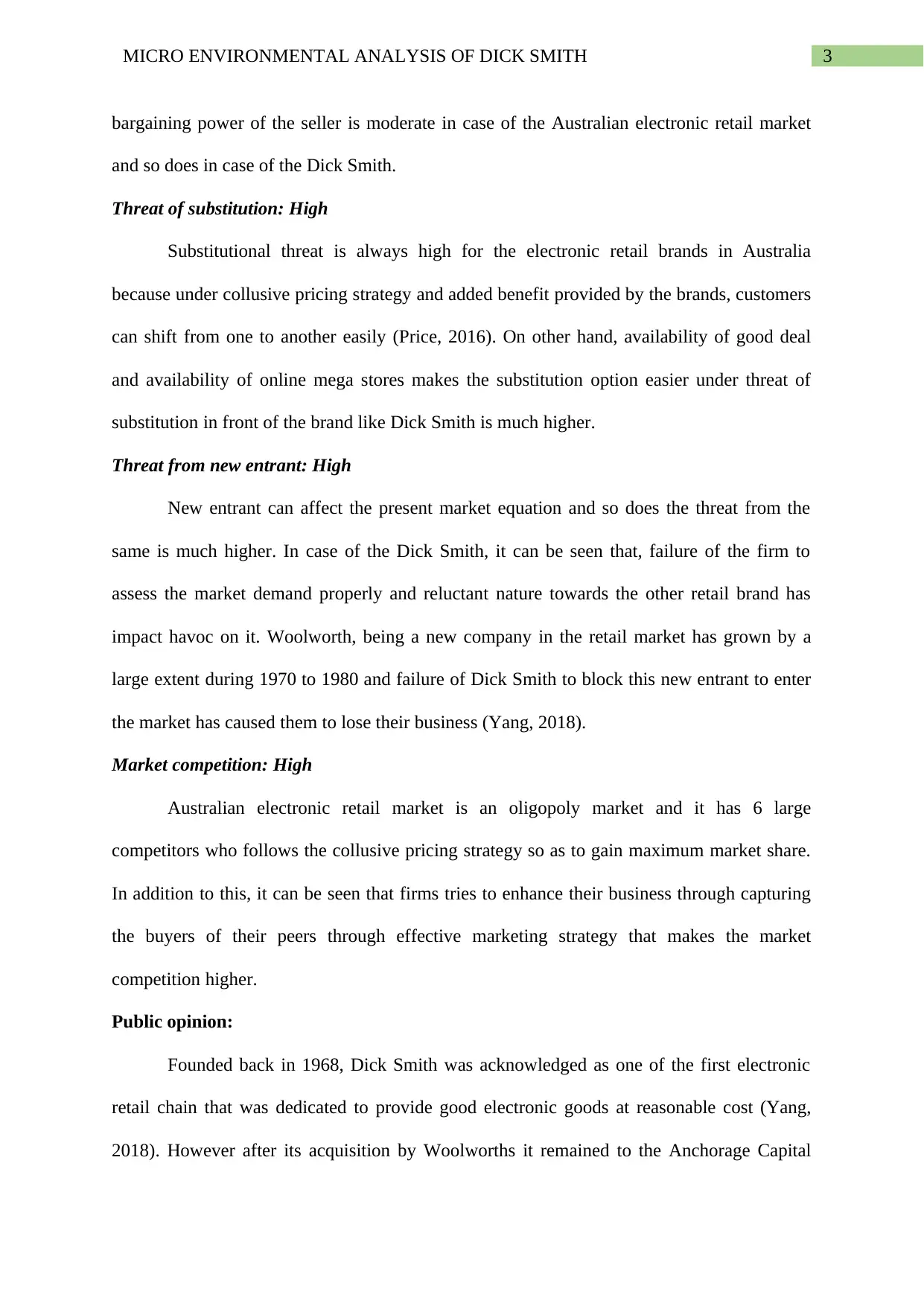
3MICRO ENVIRONMENTAL ANALYSIS OF DICK SMITH
bargaining power of the seller is moderate in case of the Australian electronic retail market
and so does in case of the Dick Smith.
Threat of substitution: High
Substitutional threat is always high for the electronic retail brands in Australia
because under collusive pricing strategy and added benefit provided by the brands, customers
can shift from one to another easily (Price, 2016). On other hand, availability of good deal
and availability of online mega stores makes the substitution option easier under threat of
substitution in front of the brand like Dick Smith is much higher.
Threat from new entrant: High
New entrant can affect the present market equation and so does the threat from the
same is much higher. In case of the Dick Smith, it can be seen that, failure of the firm to
assess the market demand properly and reluctant nature towards the other retail brand has
impact havoc on it. Woolworth, being a new company in the retail market has grown by a
large extent during 1970 to 1980 and failure of Dick Smith to block this new entrant to enter
the market has caused them to lose their business (Yang, 2018).
Market competition: High
Australian electronic retail market is an oligopoly market and it has 6 large
competitors who follows the collusive pricing strategy so as to gain maximum market share.
In addition to this, it can be seen that firms tries to enhance their business through capturing
the buyers of their peers through effective marketing strategy that makes the market
competition higher.
Public opinion:
Founded back in 1968, Dick Smith was acknowledged as one of the first electronic
retail chain that was dedicated to provide good electronic goods at reasonable cost (Yang,
2018). However after its acquisition by Woolworths it remained to the Anchorage Capital
bargaining power of the seller is moderate in case of the Australian electronic retail market
and so does in case of the Dick Smith.
Threat of substitution: High
Substitutional threat is always high for the electronic retail brands in Australia
because under collusive pricing strategy and added benefit provided by the brands, customers
can shift from one to another easily (Price, 2016). On other hand, availability of good deal
and availability of online mega stores makes the substitution option easier under threat of
substitution in front of the brand like Dick Smith is much higher.
Threat from new entrant: High
New entrant can affect the present market equation and so does the threat from the
same is much higher. In case of the Dick Smith, it can be seen that, failure of the firm to
assess the market demand properly and reluctant nature towards the other retail brand has
impact havoc on it. Woolworth, being a new company in the retail market has grown by a
large extent during 1970 to 1980 and failure of Dick Smith to block this new entrant to enter
the market has caused them to lose their business (Yang, 2018).
Market competition: High
Australian electronic retail market is an oligopoly market and it has 6 large
competitors who follows the collusive pricing strategy so as to gain maximum market share.
In addition to this, it can be seen that firms tries to enhance their business through capturing
the buyers of their peers through effective marketing strategy that makes the market
competition higher.
Public opinion:
Founded back in 1968, Dick Smith was acknowledged as one of the first electronic
retail chain that was dedicated to provide good electronic goods at reasonable cost (Yang,
2018). However after its acquisition by Woolworths it remained to the Anchorage Capital
Paraphrase This Document
Need a fresh take? Get an instant paraphrase of this document with our AI Paraphraser
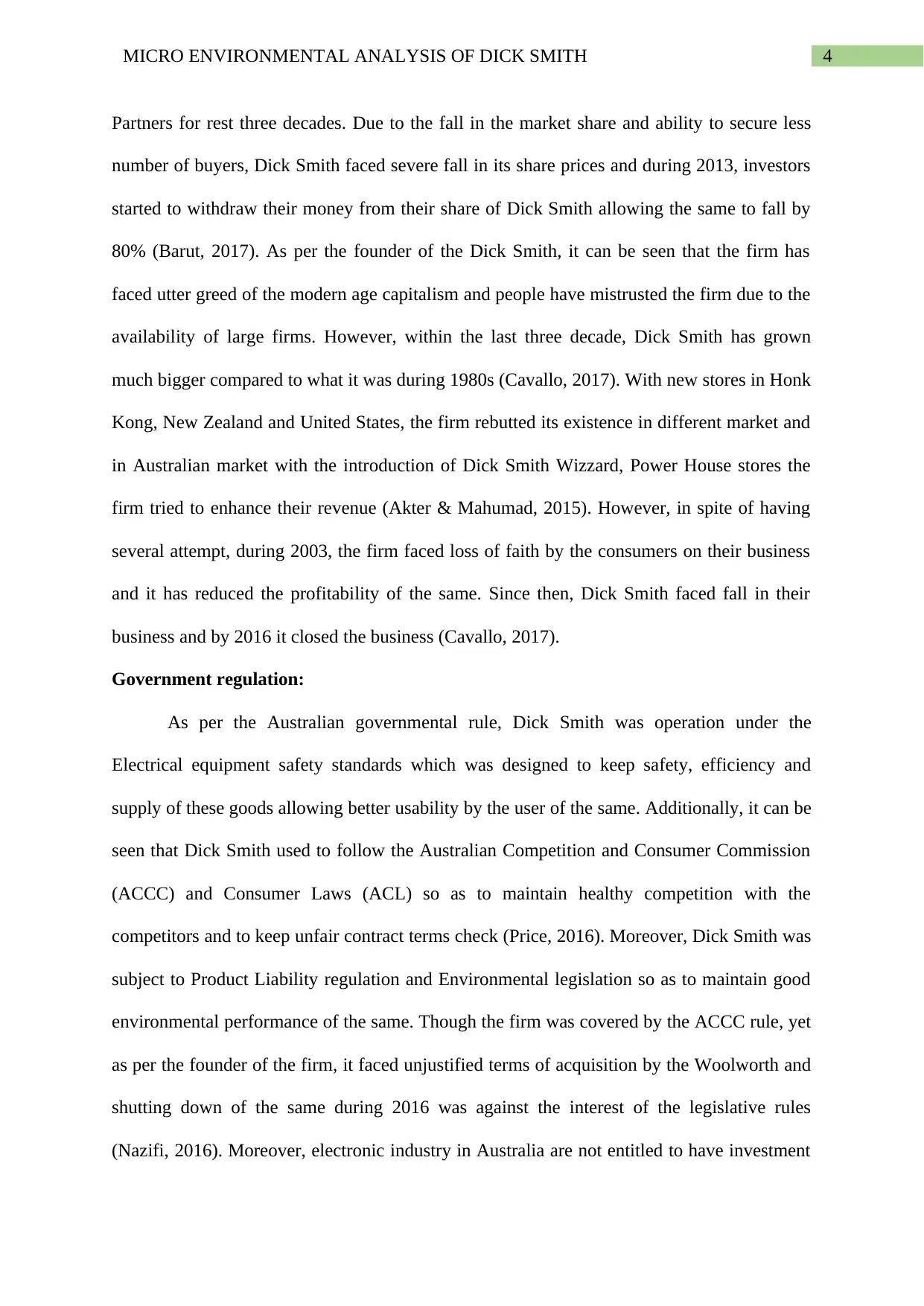
4MICRO ENVIRONMENTAL ANALYSIS OF DICK SMITH
Partners for rest three decades. Due to the fall in the market share and ability to secure less
number of buyers, Dick Smith faced severe fall in its share prices and during 2013, investors
started to withdraw their money from their share of Dick Smith allowing the same to fall by
80% (Barut, 2017). As per the founder of the Dick Smith, it can be seen that the firm has
faced utter greed of the modern age capitalism and people have mistrusted the firm due to the
availability of large firms. However, within the last three decade, Dick Smith has grown
much bigger compared to what it was during 1980s (Cavallo, 2017). With new stores in Honk
Kong, New Zealand and United States, the firm rebutted its existence in different market and
in Australian market with the introduction of Dick Smith Wizzard, Power House stores the
firm tried to enhance their revenue (Akter & Mahumad, 2015). However, in spite of having
several attempt, during 2003, the firm faced loss of faith by the consumers on their business
and it has reduced the profitability of the same. Since then, Dick Smith faced fall in their
business and by 2016 it closed the business (Cavallo, 2017).
Government regulation:
As per the Australian governmental rule, Dick Smith was operation under the
Electrical equipment safety standards which was designed to keep safety, efficiency and
supply of these goods allowing better usability by the user of the same. Additionally, it can be
seen that Dick Smith used to follow the Australian Competition and Consumer Commission
(ACCC) and Consumer Laws (ACL) so as to maintain healthy competition with the
competitors and to keep unfair contract terms check (Price, 2016). Moreover, Dick Smith was
subject to Product Liability regulation and Environmental legislation so as to maintain good
environmental performance of the same. Though the firm was covered by the ACCC rule, yet
as per the founder of the firm, it faced unjustified terms of acquisition by the Woolworth and
shutting down of the same during 2016 was against the interest of the legislative rules
(Nazifi, 2016). Moreover, electronic industry in Australia are not entitled to have investment
Partners for rest three decades. Due to the fall in the market share and ability to secure less
number of buyers, Dick Smith faced severe fall in its share prices and during 2013, investors
started to withdraw their money from their share of Dick Smith allowing the same to fall by
80% (Barut, 2017). As per the founder of the Dick Smith, it can be seen that the firm has
faced utter greed of the modern age capitalism and people have mistrusted the firm due to the
availability of large firms. However, within the last three decade, Dick Smith has grown
much bigger compared to what it was during 1980s (Cavallo, 2017). With new stores in Honk
Kong, New Zealand and United States, the firm rebutted its existence in different market and
in Australian market with the introduction of Dick Smith Wizzard, Power House stores the
firm tried to enhance their revenue (Akter & Mahumad, 2015). However, in spite of having
several attempt, during 2003, the firm faced loss of faith by the consumers on their business
and it has reduced the profitability of the same. Since then, Dick Smith faced fall in their
business and by 2016 it closed the business (Cavallo, 2017).
Government regulation:
As per the Australian governmental rule, Dick Smith was operation under the
Electrical equipment safety standards which was designed to keep safety, efficiency and
supply of these goods allowing better usability by the user of the same. Additionally, it can be
seen that Dick Smith used to follow the Australian Competition and Consumer Commission
(ACCC) and Consumer Laws (ACL) so as to maintain healthy competition with the
competitors and to keep unfair contract terms check (Price, 2016). Moreover, Dick Smith was
subject to Product Liability regulation and Environmental legislation so as to maintain good
environmental performance of the same. Though the firm was covered by the ACCC rule, yet
as per the founder of the firm, it faced unjustified terms of acquisition by the Woolworth and
shutting down of the same during 2016 was against the interest of the legislative rules
(Nazifi, 2016). Moreover, electronic industry in Australia are not entitled to have investment
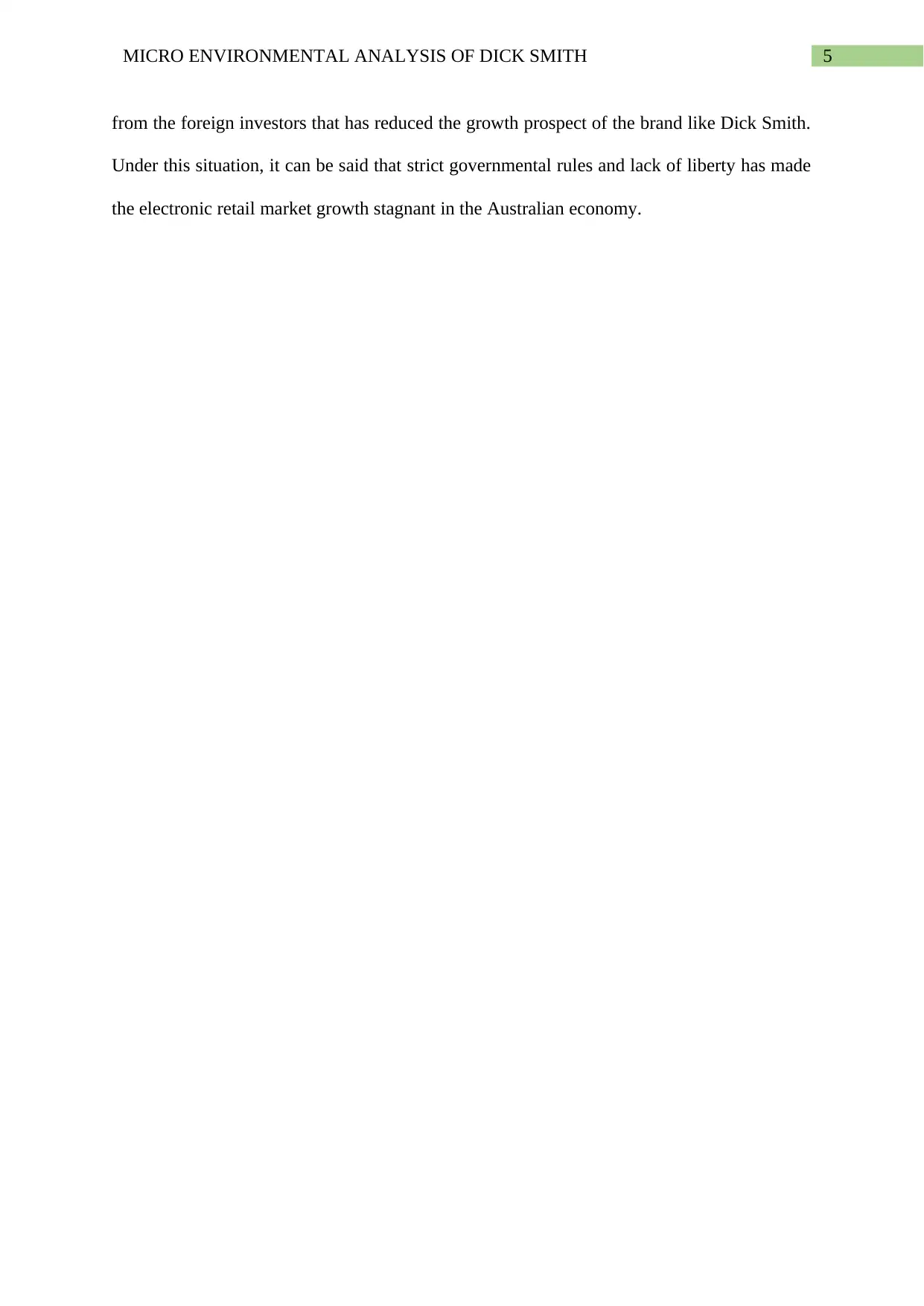
5MICRO ENVIRONMENTAL ANALYSIS OF DICK SMITH
from the foreign investors that has reduced the growth prospect of the brand like Dick Smith.
Under this situation, it can be said that strict governmental rules and lack of liberty has made
the electronic retail market growth stagnant in the Australian economy.
from the foreign investors that has reduced the growth prospect of the brand like Dick Smith.
Under this situation, it can be said that strict governmental rules and lack of liberty has made
the electronic retail market growth stagnant in the Australian economy.
⊘ This is a preview!⊘
Do you want full access?
Subscribe today to unlock all pages.

Trusted by 1+ million students worldwide
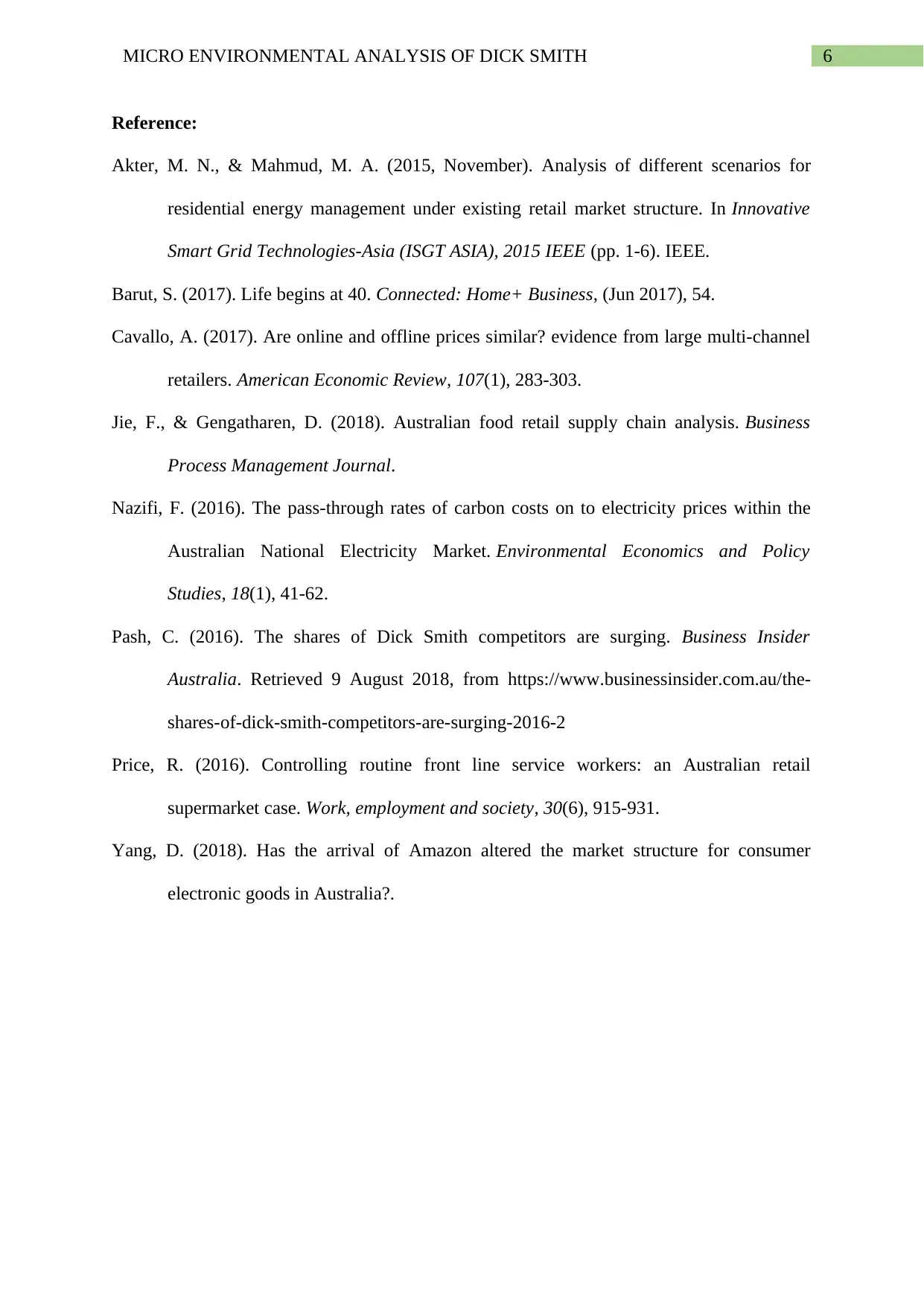
6MICRO ENVIRONMENTAL ANALYSIS OF DICK SMITH
Reference:
Akter, M. N., & Mahmud, M. A. (2015, November). Analysis of different scenarios for
residential energy management under existing retail market structure. In Innovative
Smart Grid Technologies-Asia (ISGT ASIA), 2015 IEEE (pp. 1-6). IEEE.
Barut, S. (2017). Life begins at 40. Connected: Home+ Business, (Jun 2017), 54.
Cavallo, A. (2017). Are online and offline prices similar? evidence from large multi-channel
retailers. American Economic Review, 107(1), 283-303.
Jie, F., & Gengatharen, D. (2018). Australian food retail supply chain analysis. Business
Process Management Journal.
Nazifi, F. (2016). The pass-through rates of carbon costs on to electricity prices within the
Australian National Electricity Market. Environmental Economics and Policy
Studies, 18(1), 41-62.
Pash, C. (2016). The shares of Dick Smith competitors are surging. Business Insider
Australia. Retrieved 9 August 2018, from https://www.businessinsider.com.au/the-
shares-of-dick-smith-competitors-are-surging-2016-2
Price, R. (2016). Controlling routine front line service workers: an Australian retail
supermarket case. Work, employment and society, 30(6), 915-931.
Yang, D. (2018). Has the arrival of Amazon altered the market structure for consumer
electronic goods in Australia?.
Reference:
Akter, M. N., & Mahmud, M. A. (2015, November). Analysis of different scenarios for
residential energy management under existing retail market structure. In Innovative
Smart Grid Technologies-Asia (ISGT ASIA), 2015 IEEE (pp. 1-6). IEEE.
Barut, S. (2017). Life begins at 40. Connected: Home+ Business, (Jun 2017), 54.
Cavallo, A. (2017). Are online and offline prices similar? evidence from large multi-channel
retailers. American Economic Review, 107(1), 283-303.
Jie, F., & Gengatharen, D. (2018). Australian food retail supply chain analysis. Business
Process Management Journal.
Nazifi, F. (2016). The pass-through rates of carbon costs on to electricity prices within the
Australian National Electricity Market. Environmental Economics and Policy
Studies, 18(1), 41-62.
Pash, C. (2016). The shares of Dick Smith competitors are surging. Business Insider
Australia. Retrieved 9 August 2018, from https://www.businessinsider.com.au/the-
shares-of-dick-smith-competitors-are-surging-2016-2
Price, R. (2016). Controlling routine front line service workers: an Australian retail
supermarket case. Work, employment and society, 30(6), 915-931.
Yang, D. (2018). Has the arrival of Amazon altered the market structure for consumer
electronic goods in Australia?.
1 out of 7
Related Documents
Your All-in-One AI-Powered Toolkit for Academic Success.
+13062052269
info@desklib.com
Available 24*7 on WhatsApp / Email
![[object Object]](/_next/static/media/star-bottom.7253800d.svg)
Unlock your academic potential
Copyright © 2020–2025 A2Z Services. All Rights Reserved. Developed and managed by ZUCOL.





